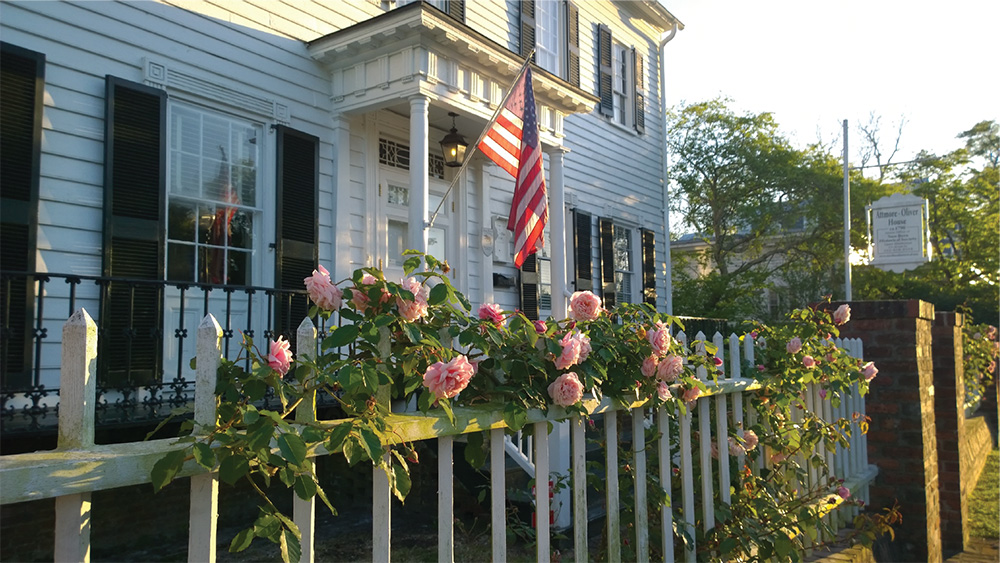The Forgotten Keepers of the Light
NBHS Historian/Claudia Houston
The lighthouses of North Carolina helped guide ships through treacherous waters, and lighthouse keepers tended their lights with quiet dedication. Among these unsung guardians were two sisters from New Bern—Martha Annie and Susan Dena McCotter. Their remarkable yet forgotten contributions helped keep sailors safe along the Carolina coast.
Annie and Susan, born to John T. McCotter and Narcissus Paul, faced adversity early. Their father died at the young age of twenty-seven, and their mother supported the family by tailoring.
During the Civil War, Union soldier Charles B. Keeler from Wallingford, Connecticut, was stationed in New Bern as part of the First Connecticut Heavy Artillery. Charles met Annie and fell in love, and their romance led to marriage on January 29, 1865. Charles mustered out in July 1865 as a second-class musician, and the newly married Keeler family moved north to Bridgeport, Connecticut, taking Annie’s mother and her older sister, Susan, with them. Per the 1870 census, the family continued to reside together, and Charles found work as a liquor and billiard salesman.
During this time, Charles’s brother Edward, residing with his parents in Wallingford, grew close to Susan. Though no marriage record has been found, the 1880 census shows both couples living on Portsmouth Island in Carteret County, North Carolina. By then, the Keeler brothers had become lighthouse keepers—a role demanding grit, vigilance, and resilience. As was customary at the time, their wives initially became unofficial assistants.
Charles served as Principal Keeper at several stations, including the Brant Island Shoal and the Southwest Point Royal Shoal Lighthouses, from 1887 to 1900, earning $600 yearly. Edward was Principal Keeper at Northwest and Southwest Point Royal Shoals from 1901 to 1905, earning the same salary. Portsmouth Island became home, and lighthouse keeping was a family affair.
William Keeler, the brothers’ father, moved from Connecticut to Portsmouth to join his sons and spent his final years on the island until he died in 1885. He was laid to rest in the small Keeler-Styron Cemetery in Portsmouth.
Tragedy struck in 1900 when Charles was caught in a violent storm on his way home from New Bern. He succumbed to exposure and died on June 25, 1900, and was buried next to his father in the Portsmouth Island cemetery.
I t should be noted that women were rarely recognized in official records. Most women employed at North Carolina lighthouses were wives of the head lightkeepers. Their stories are unknown or forgotten. These women supported their husbands and did the same grueling and tedious work to keep the lighthouses lit and running. This included maintaining logs, hauling oil, polishing brass, cleaning lenses, and ensuring the lights stayed lit during the darkest nights and fiercest storms.
t should be noted that women were rarely recognized in official records. Most women employed at North Carolina lighthouses were wives of the head lightkeepers. Their stories are unknown or forgotten. These women supported their husbands and did the same grueling and tedious work to keep the lighthouses lit and running. This included maintaining logs, hauling oil, polishing brass, cleaning lenses, and ensuring the lights stayed lit during the darkest nights and fiercest storms.
Both sisters were acknowledged in the Register of Officers and Agents, Civil, Military, and Naval in the Service of the United States. Martha Annie Keeler was listed as Assistant Keeper at the Southwest Point Royal Shoal Lighthouse from 1891 to 1899, and Susan Keeler served at both Northwest and Southwest Shoals from 1897 to 1903. They earned $440 a year for their service.
 Edward died in 1905 and was buried with his brother and father. The sisters lived together until Susan died in 1918. Annie passed away two years later in 1920. For reasons unknown, the brothers were disinterred from Portsmouth Island and reinterred in Cedar Grove Cemetery in October 1905. Annie and Susan were united in death at Cedar Grove with their husbands and the rest of the McCotter family.
Edward died in 1905 and was buried with his brother and father. The sisters lived together until Susan died in 1918. Annie passed away two years later in 1920. For reasons unknown, the brothers were disinterred from Portsmouth Island and reinterred in Cedar Grove Cemetery in October 1905. Annie and Susan were united in death at Cedar Grove with their husbands and the rest of the McCotter family.
The McCotter sisters were more than wives to lighthouse keepers—they were keepers of the light themselves. In a time when women’s roles were often overshadowed, Annie and Susan faithfully tended the beacons that safeguarded lives. Let us remember these quiet heroines—not just for their service but for their strength, resilience, and unyielding dedication to keeping the light shining.


